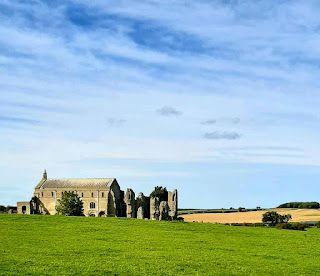Today I took advantage of the opportunity to visit as many churches as possible on behalf of The Norfolk Churches Trust. Happily joining two chums we clocked up 40 km on our bikes and visited 10 churches. Our beautiful day with perfect weather conditions started at Cockthorpe on the chalk ridge just above Stiffkey with views to the marshes.
The small compact Cockthorpe church is near Langham Dome were pilots were trained in a state of the art facility in WW2.
We then took in Langham where the light streamed in through simple stained glass windows.
I particularly loved this distressed Rood Screen at the back of Langham Church.
We then rode down the hill from Langham with a perfect view of Blakeney point at high tide to Moreston church. Here I embarked on singing the first of my sacred arias. The steward liked this.
My chums Kate and Caroline were incredibly upbeat. It makes all the difference to have such lovely companions to share these great experiences. Here is Kate contemplating her mobile phone!
Then on to Blakeney which has a curious extra tower which may have been used to alert ships at sea. The church itself is somewhat ruined by a Victorian Rood screen which would be great to pull down. The steward rather ostentatiously called his church a cathedral which it is not! On to Wiveton with extraordinary views across the Glaven valley to Cley church which is nearly a cathedral since it was built by Norwich Cathedral's master builder and is proportionally much larger than a church.
In Wiveton I sang 'Come unto him, all ye that labour" from Handel's Messiah since there was an inscription of the words from the gospel of Matthew on the wall. What was particularly fascinating was an artist's impressions of how the port of Cley would have looked at the height of the wool trade.
Biking across the humped bridge over to Cley we saw the clearest water in the stream below. Cley church itself is deeply impressive.
The door is also grand.
In Cley church a painted lady hovered numinously on the high altar carpet.
The sun shone in through the high clear windows and the tress quivered in a light breeze outside.
I sang Bach's Agnus Dei from the B Minor mass.
The sheer vastness of the church conveys what an important statement it made.
There are many amazing stone carvings at Cley such as this musician with a drum.
Also one of St George and the dragon. But it was this detail on the baptismal font that caught my eye.
We rode on to Salthouse down the back of Cley along Old Woman's Lane. The view from Salthouse church is to the North Sea. A few tasty snacks were picked up in the village shop and happily consumed on the green. Then we had a gruelling climb up to Salthosue heath back on the top of the chalk ridge that runs parallel to the Norfolk coast. I happily admit that I was reduced to pushing near the top!
We then wended our way back past Wiveton and up the river valley to Glandford which has Dutch style dwellings. Its gem is the most extraordinary shell museum which the verger of the church behind gladly opened up for us. I sang part of Delila's aria from Saen Saens; Sampson an Delilah since his cute baby girl was called Delilah.
The inside of the museum is a adorable and would be a great venue for a simple concert.
There is every kind of shell specimen you can imagine, this one caught my eye.
Onwards we went on to the churches at Saxlington and Field Dalling where the sun shone joyfully through the stained glass windows.
But the best was left till last with the gorgeously situated ruined Benedictine Priory at Binham.
One can really imagine that this must have been a glorious spot for a monastery with its clear river and near access to the sea but shielded from its tempestuous rigours by the ever present chalk ridge rising behind. The inside is no less impressive with its tiered Saxon arches and beautiful acoustics. I sang Laschia Chio Pianga by Handel.
Finally our journey nearly complete we visited the Raw Milk Cafe and heartily consumed the most delicious ice cream.












































